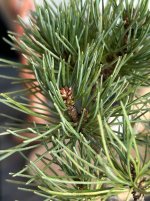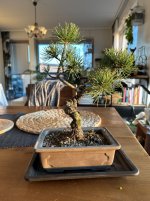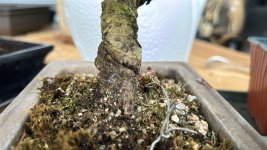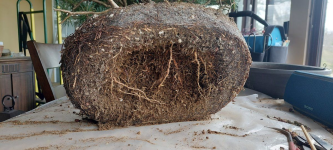Bepo
Seedling
Hello! I'm new to this site and to bonsai so I've come here for advice.
I got this Japanese White Pine last week and I noticed that the soil is really compact. I read that JWP likes a well draining substrate and really likes oxygen for the roots so I'm planning on repotting it.
So a couple of questions:
1.Is it too late to repot?
I've read that repotting should be done in early spring. Its april already and we have had abnormally warm and sunny weather here in southern Finland so Im afraid Im late.
Some sources I've seen recommend repotting before the buds swell and some during it. I tried to get some pictures of the buds, if someone can say if its still okay to repot.
Also attached is a picture of soil above and from the side. The roots are not pot bound so no need to report because of that, but im worried the roots are not fine because of the compact soil. You can see the marks where I tried to dig in the soil with my finger.
2.If I repot what kind of substrate do you recommend?
I have 1-5mm granularity akadama and Crushed pumice 2-5mm and Im thinking of creating a mix of around 60% pumice and 40% akadama. As I have no before knowledge of substrates is this mix "airy" enough for JWP?
3. Aftercare?
Despite of the warm weather we have light frost for the whole next week so Im planning on taking the plant inside to shield it from the frost. Or is it better to wait that the cold weather passes and then repot (if to repot at all)?
This is the beginning of my bonsai journey and appreciate all the help I get
I got this Japanese White Pine last week and I noticed that the soil is really compact. I read that JWP likes a well draining substrate and really likes oxygen for the roots so I'm planning on repotting it.
So a couple of questions:
1.Is it too late to repot?
I've read that repotting should be done in early spring. Its april already and we have had abnormally warm and sunny weather here in southern Finland so Im afraid Im late.
Some sources I've seen recommend repotting before the buds swell and some during it. I tried to get some pictures of the buds, if someone can say if its still okay to repot.
Also attached is a picture of soil above and from the side. The roots are not pot bound so no need to report because of that, but im worried the roots are not fine because of the compact soil. You can see the marks where I tried to dig in the soil with my finger.
2.If I repot what kind of substrate do you recommend?
I have 1-5mm granularity akadama and Crushed pumice 2-5mm and Im thinking of creating a mix of around 60% pumice and 40% akadama. As I have no before knowledge of substrates is this mix "airy" enough for JWP?
3. Aftercare?
Despite of the warm weather we have light frost for the whole next week so Im planning on taking the plant inside to shield it from the frost. Or is it better to wait that the cold weather passes and then repot (if to repot at all)?
This is the beginning of my bonsai journey and appreciate all the help I get

















